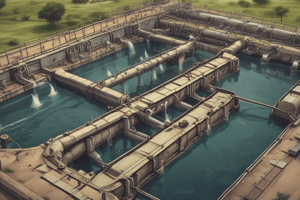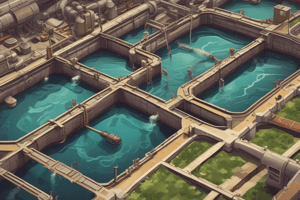Podcast
Questions and Answers
What is the purpose of using chlorine and ozone in wastewater treatment?
What is the purpose of using chlorine and ozone in wastewater treatment?
- To accelerate the sedimentation process
- To remove large objects from water
- To increase the BOD levels in water
- To disinfect water (correct)
Which element of 'My Identity' is directly related to the topic of wastewater treatment?
Which element of 'My Identity' is directly related to the topic of wastewater treatment?
- My Family
- My Health
- My Community (correct)
- My Environment
What is the consequence of high Biological Oxygen Demand (BOD) levels in water?
What is the consequence of high Biological Oxygen Demand (BOD) levels in water?
- Causes oxygen depletion (correct)
- Indicates clean water
- Promotes aquatic life
- Enhances water clarity
Why should cooking oil and fats not be disposed of in drainage systems?
Why should cooking oil and fats not be disposed of in drainage systems?
Which of the following is NOT a source of sewage?
Which of the following is NOT a source of sewage?
What role do manholes play in the sewage system?
What role do manholes play in the sewage system?
Which of the following is a low-cost sewage disposal system?
Which of the following is a low-cost sewage disposal system?
What is the first step in the wastewater treatment process?
What is the first step in the wastewater treatment process?
What role does compressed air play in the aeration tank during wastewater treatment?
What role does compressed air play in the aeration tank during wastewater treatment?
Why is it important to slow down the speed of incoming wastewater in the grit and sand removal tank?
Why is it important to slow down the speed of incoming wastewater in the grit and sand removal tank?
What is one reason why medicines should not be thrown down the drain?
What is one reason why medicines should not be thrown down the drain?
What is sludge in the context of wastewater treatment?
What is sludge in the context of wastewater treatment?
How does untreated human excreta pose a health hazard?
How does untreated human excreta pose a health hazard?
What function do bar screens serve in a wastewater treatment plant?
What function do bar screens serve in a wastewater treatment plant?
What is the primary purpose of a septic tank?
What is the primary purpose of a septic tank?
What should you do as an active citizen to maintain public sanitation?
What should you do as an active citizen to maintain public sanitation?
Flashcards
Aeration Tank Function
Aeration Tank Function
Aeration tanks supply oxygen for aerobic bacteria to decompose organic matter.
Grit and Sand Removal
Grit and Sand Removal
The process slows wastewater to allow solids like sand and grit to settle.
Role of Active Citizen
Role of Active Citizen
Responsibilities include keeping surroundings clean and managing sewage properly.
Medicines in Drains
Medicines in Drains
Signup and view all the flashcards
Untreated Human Excreta
Untreated Human Excreta
Signup and view all the flashcards
Bar Screens
Bar Screens
Signup and view all the flashcards
Septic Tank Mechanism
Septic Tank Mechanism
Signup and view all the flashcards
Relation of Sanitation to Diseases
Relation of Sanitation to Diseases
Signup and view all the flashcards
BOD
BOD
Signup and view all the flashcards
Sewage
Sewage
Signup and view all the flashcards
Sewage Treatment
Sewage Treatment
Signup and view all the flashcards
Manhole
Manhole
Signup and view all the flashcards
Low-cost sewage disposal systems
Low-cost sewage disposal systems
Signup and view all the flashcards
Chlorine and Ozone
Chlorine and Ozone
Signup and view all the flashcards
Harmful effects of sewage
Harmful effects of sewage
Signup and view all the flashcards
Steps to clarify water
Steps to clarify water
Signup and view all the flashcards
Study Notes
Wastewater Treatment
- Sewage: Wastewater from homes, industries, and hospitals; contains harmful microbes. Untreated sewage pollutes water sources and causes illness.
- Sewers: Underground pipes transporting sewage.
- Sewage Treatment: Removing pollutants from sewage.
- Sewage Treatment Plant (STP): Facility where sewage is treated.
- Manhole: Covered vertical hole above underground sewers for access to pipes for cleaning and repairs. Manholes are placed at junctions of sewers or pipeline changes every 50-60 meters.
- Contaminants: Impurities in wastewater.
- Sludge: Solid waste that settles during treatment. Treated by anaerobic bacteria, producing biogas for energy.
Sanitation and Health
- Poor sanitation leads to diseases: Typhoid, cholera are examples. Contaminated water spreads infections causing health problems.
- Septic Tank: Underground tank for treating household sewage. Solid waste settles and decomposes by bacteria; clarified water exits through an outlet.
- Medicines in drains: Should not be thrown in as they can kill useful microbes needed for decomposition and water purification.
- Untreated human excreta: A health hazard; causes poor sanitation, water and soil pollution, and diseases (cholera, typhoid, dysentery).
- Citizen Role: Keep surroundings clean, manage home sewerage, report leaks, avoid littering, keep water sources clean, cover open drains, and practice good sanitation.
Wastewater Treatment Plant (WWTP) Processes
- Screening: Removes large objects (plastic bags, rags, sticks) using bar screens.
- Grit and Sand Removal: Slows down wastewater to allow grit, sand, and pebbles to settle.
- Primary Sedimentation: Heavy solids settle at the bottom.
- Skimming: Removes floating oil and grease.
- Clarified Water: Free of solid and floating impurities.
- Aerating tank: Compressed air provides oxygen for aerobic bacteria that break down organic matter. Without this, decomposition is slower or ineffective.
- BOD (Biochemical Oxygen Demand): Measures oxygen needed by bacteria to break down organic matter in water. High BOD indicates pollution.
Wastewater Management Issues
- Harmful effects of sewage: Spreads diseases, produces foul odor and pollution, causes waterborne diseases, blocks drains, and attracts insects and mosquitoes.
- Cooking oil/fats: Should not be thrown down drains as they harden and block pipes, reducing drainage efficiency.
- Solid wastes (tea leaves, food remains, cotton): Should not be thrown in drains; they choke drains and block oxygen for beneficial microbes.
- Chemicals (paints, solvents): Should not be disposed of in drains as they kill beneficial microbes important for waste decomposition and water purification.
- Low-cost sewage disposal systems: Septic tanks, chemical toilets, vermicomposting toilets, biogas plants, composting pits offer alternatives to centralized systems.
- Disinfection: Chlorine and ozone.
Definitions
- Sewage: Wastewater carried away in sewers.
- Sewerage: Network of pipes carrying sewage.
- Cleaning water: Removing pollutants from water.
- Dried sludge: Used as manure.
Waste management in the UAE
- Abu Dhabi Sewerage Services Company (ADSSC): Collects and treats wastewater in Abu Dhabi.
Additional Information
- Sources of sewage: Domestic, commercial, industrial, and rainwater.
Studying That Suits You
Use AI to generate personalized quizzes and flashcards to suit your learning preferences.




